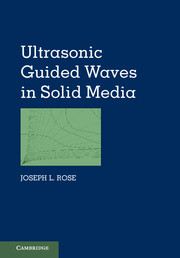Book contents
- Frontmatter
- Contents
- Nomenclature
- Preface
- Acknowledgments
- 1 Introduction
- 2 Dispersion Principles
- 3 Unbounded Isotropic and Anisotropic Media
- 4 Reflection and Refraction
- 5 Oblique Incidence
- 6 Waves in Plates
- 7 Surface and Subsurface Waves
- 8 Finite Element Method for Guided Wave Mechanics
- 9 The Semi-Analytical Finite Element Method
- 10 Guided Waves in Hollow Cylinders
- 11 Circumferential Guided Waves
- 12 Guided Waves in Layered Structures
- 13 Source Influence on Guided Wave Excitation
- 14 Horizontal Shear
- 15 Guided Waves in Anisotropic Media
- 16 Guided Wave Phased Arrays in Piping
- 17 Guided Waves in Viscoelastic Media
- 18 Ultrasonic Vibrations
- 19 Guided Wave Array Transducers
- 20 Introduction to Guided Wave Nonlinear Methods
- 21 Guided Wave Imaging Methods
- Appendix A Ultrasonic Nondestructive Testing Principles, Analysis, and Display Technology
- Appendix B Basic Formulas and Concepts in the Theory of Elasticity
- Appendix C Physically Based Signal Processing Concepts for Guided Waves
- Appendix D Guided Wave Mode and Frequency Selection Tips
- Index
- Plates
- References
7 - Surface and Subsurface Waves
Published online by Cambridge University Press: 05 July 2014
- Frontmatter
- Contents
- Nomenclature
- Preface
- Acknowledgments
- 1 Introduction
- 2 Dispersion Principles
- 3 Unbounded Isotropic and Anisotropic Media
- 4 Reflection and Refraction
- 5 Oblique Incidence
- 6 Waves in Plates
- 7 Surface and Subsurface Waves
- 8 Finite Element Method for Guided Wave Mechanics
- 9 The Semi-Analytical Finite Element Method
- 10 Guided Waves in Hollow Cylinders
- 11 Circumferential Guided Waves
- 12 Guided Waves in Layered Structures
- 13 Source Influence on Guided Wave Excitation
- 14 Horizontal Shear
- 15 Guided Waves in Anisotropic Media
- 16 Guided Wave Phased Arrays in Piping
- 17 Guided Waves in Viscoelastic Media
- 18 Ultrasonic Vibrations
- 19 Guided Wave Array Transducers
- 20 Introduction to Guided Wave Nonlinear Methods
- 21 Guided Wave Imaging Methods
- Appendix A Ultrasonic Nondestructive Testing Principles, Analysis, and Display Technology
- Appendix B Basic Formulas and Concepts in the Theory of Elasticity
- Appendix C Physically Based Signal Processing Concepts for Guided Waves
- Appendix D Guided Wave Mode and Frequency Selection Tips
- Index
- Plates
- References
Summary
Background
The existence of surface waves was predicted theoretically over a century ago. Elastic waves propagating along the surface of a half-space were first predicted by Lord Rayleigh in 1885 in his paper “On waves propagating along the plane surface of an elastic bar,” submitted to the Proceedings of the London Mathematical Society. It is telling that this paper was submitted to a mathematical society and not a physical society, as such surface waves were primarily a mathematical concept, although Lord Rayleigh did suspect that they would be relevant to seismology. By the middle of the twentieth century, however, surface waves began to enter into mainstream technological applications. These waves, often referred to as Rayleigh waves or surface acoustic waves (SAW), are now being employed in a number of areas of science and technology, including ultrasonic NDE and SHM, seismology, and electronic circuitry. There is much literature on this subject, including for example Chadwick and Smith (1977), Farnell (1970), Pollard (1977), and Viktorov (1967). Experimental evidence was first obtained in observing wave propagation over the surface of the earth (as a result of earthquakes) and subsequent mode conversion at the earth’s surface. Observations were made regarding the unusual behavior of energy decay with increased depth and the ability of waves to travel along curved surfaces.
This chapter examines surface waves on an isotropic, homogeneous, linear elastic semi-space. We take a rather classical approach to-the problem, one that is based on potential functions and boundary conditions for a free surface. Assumptions of isotropy, homogeneity, and linear elastic response will also be made. For more detail, see Auld (1990), Basatskaya and Ermolov (1980), Couchman and Bell (1978), Heelan (1953), Kolsky (1963), Nikiforov and Kharitonov (1981), Pilarski and Rose (1989), Uberall (1973), and Viktorov (1967).
Information
- Type
- Chapter
- Information
- Ultrasonic Guided Waves in Solid Media , pp. 107 - 119Publisher: Cambridge University PressPrint publication year: 2014
References
Accessibility standard: Unknown
Why this information is here
This section outlines the accessibility features of this content - including support for screen readers, full keyboard navigation and high-contrast display options. This may not be relevant for you.Accessibility Information
- 1
- Cited by
